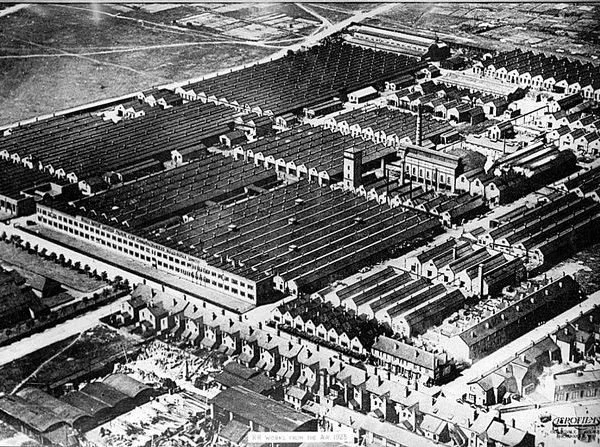Ernest Townsend
///bigger.prompting.flows
Ernest Townsend, a British portraitist from Derby, died 22 January 1944.
Ernest Townsend was born in Parliament Street in Derby on 1st January 1880, the eighth child of James Townsend who was a coach builder with Holmes of Derby. Coach building had been the Townsend profession practiced for at least three generations. James' father, William, had moved from Bitton in Gloucestershire to Newark in around 1850 and then to Derby in the late 1850s.
Ernest's early education was at Abbey Street School and at the age of 14 he was apprenticed to a firm of architects, Wright and Thorpe, practicing at 23 St James St, Derby. Thomas Harrison Thorpe, the junior partner, recognised Townsend's artistic ability immediately and a lifelong friendship developed between them. Ernest’s brother William George Paulson Townsend was a major influence on Ernest’s early artistic interests. William studied at Derby Technical and Art College and later the Royal College of Art, South Kensington, introducing Ernest to scholars, educators and clients.
Townsend's early promise was justified and eventually he left architecture altogether and embarked on a full-time course at the Heatherly School of Fine Art in London. He then moved to a five-year course at the School of Painting at the Royal Academy. Amongst his tutors at the Academy Schools were John Singer Sargent and Lawrence Alma-Tadema. His friends included Aubrey Beardsley, Alfred Munnings, Augustus John, and Laura Knight. Townsend exhibited 15 pintings at the academy between 1910 and 1937.
As an art student, he lived with his brother, William George Paulson Townsend, who had become Design Master at the Royal School of Needlework and was an author and editor of various art publications. Ernest supplemented his income with design work for these magazines, in particular for The Art Workers' Quarterly, of which his brother was founder and editor.
In 1904 he won the Royal Academy's Landseer Scholarship for figure painting and in 1905 he won the academy's Creswick Prize for 'Willows and Weeds', a painting donated by his family after his death to the Derby Art Gallery.
In 1907, he left London. After some time in Paris and the Netherlands, he returned to Derby, where he had a studio in Full Street, living in nearby Coxbench. In 1912, Townsend, like his friends, Alfred Munnings and Laura Knight, represented Great Britain in the Olympic Games in Stockholm by entering a painting in the Olympic Art exhibition.
At the age of 25, Townsend was commissioned to paint his former headmaster at the School of Art, T.C. Simmonds. This painting was later accepted by the Royal Academy for its 1910 Summer Exhibition. Perhaps it was this success that led to another commission from the Town of Derby for a portrait of the Libraries Museum and Art Gallery Director, William Crowther, upon his retirement in 1911. Many more "official" commissions were to come from the Town for the remainder of Townsend's life; a succession of mayoral portraits can be seen in the Council chamber today.
Townsend's 1915 portrait of the Right Hon. Winston Churchill when he was First Lord of the Admiralty was commissioned anonymously. This picture now hangs in the National Liberal Club in London, but it was not hung until 1944. Churchill had been unavailable to unveil it in 1915, and when he was available, he was no longer popular in the Liberal Club. The portrait was mothballed and retrieved for public viewing only following Churchill's success in 1944, when he was belatedly asked to unveil it.
Just as the Academy Schools had its elite band of artists—Munnings, Laura Knight, et al.—so did Derby on a lesser sca1e. Edwardian Derby had its own band of regional artists: Alfred John Keene (also noted for his fine early photography), S. H. Parkin, and Frank Gresley. These and a number of lesser known but competent artists met via the Derby Sketching Club, to which Townsend was immediately attracted. He was to remain a member of the club for the rest of his life and he found a patron in Alfred E. Goodey via the club.
It was at the Sketching Club that he met Peter Campbell and his son Percy. Peter had moved from Stockton-on-Tees to work for the Bemrose Company as a commercial artist, although he later went freelance. Campbell produced much work for the Midland Railway. The friendship led to Ernest being invited to the Campbells' home on Havelock Road in Derby, which was then almost in the country. The three men shared an interest not only in art, but in amateur music. In this they were joined by Peter's daughter, Doris, who was an accomplished pianist to her father's violin and Townsend's baritone. Doris was also a member of the Sketching Club. Townsend married Doris Campbell on 30 December 1912 at St James' Church in Clapham.
When Townsend died on 22nd January 1944, some said it was due to overwork. He had been busy during the war creating designs that could be used to camouflage Rolls-Royce's aircraft engine factories in Derby. These factories built the Merlin engines that powered the Spitfire and Hurricane fighters. Using his skills, he made the factory appear from the air to be no more than a village.
Ernest was buried in Nottingham Road Cemetery on 26th January 1944. He sadly has no headstone.
Later in 1944 Derby Art Gallery put on a memorial exhibition in his honour. Derby Art Gallery still houses a large collection of his work.
Rolls Royce works from the air 1925
Cooling tower camouflage example
Townsends unmarked grave is to the left of the cherub.





